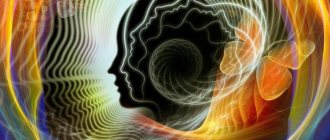Basal ganglia
The basal ganglia of the brain are responsible for the fine tuning of motor skills, take part in the processes of sensory perception and the cognitive sphere, as if modulating their fine tuning (afferences from the frontal cortex and efference to the frontal cortex through the thalamus).
The ratio of the volume of the subcortical nodes and the total volume of the brain in patients with schizophrenia shows larger values in patients with schizophrenia compared to healthy people. In schizophrenia, the total volume of the subcortical nodes is increased, however, studies devoted to the study of their shape, determining correlations of size and shape with the severity of one or another clinical symptomatology of schizophrenia are relatively rare.
There is reliable evidence that in patients with schizophrenia, the left and right globus pallidus, unlike other nuclei, are enlarged compared to healthy subjects. Some authors in their reviews indicate that this increase is generally fixed at 20%.
According to the results of studies by Lang et al. (2001), the volumes of the putamen and globus pallidus in patients with a first psychotic episode are significantly smaller than in patients suffering from schizophrenia for a long time. At the same time, a number of studies measure the lenticular nucleus, and not the globus pallidus and putamen separately, so it is premature to talk about changes in the size of the latter in schizophrenia.
Microscopic examination of the brains of patients with schizophrenia shows a slight increase in the density of neurons in the striatum , accompanied by the loss of some neurons in the prefrontal cortex . The volumes of the right and left caudate nucleus and putamen, as well as the volume of the right globus pallidus, are significantly increased in schizophrenia. These results became more apparent once total volumes were controlled for as covariates in the data. A comparative analysis of the severity of schizophrenia symptoms with the volume and shape of the subcortical nuclei showed that some parameters of cognitive impairment, in particular active attention, show a positive correlation with the volume of the caudate nucleus and putamen. On the contrary, productive symptoms such as delirium negatively correlate with the volume and size of the nucleus accumbens.
In the left caudate nucleus of the brain of patients with schizophrenia, an increased content of choline was recorded; on the contrary, this phenomenon was not noted in the putamen. Increased choline levels in the caudate nucleus may be associated with decreased glucose metabolism or disruption of the phospholipid membrane structure.
A number of studies have demonstrated that treatment with typical antipsychotics leads to an increase in the structural volume of the caudate nucleus, putamen and globus pallidus, while atypical antipsychotics do not cause such changes and even reduce the previously observed increase in the size of this brain structure (Scherk H., Falkai P., 2004). There is evidence that the volume of the caudate nucleus is reduced in size in patients with schizophrenia with a first psychotic episode.
Prescribing antipsychotics is likely to minimize this reduction in caudate volume that occurs before treatment. We believe that the question of what size the subcortical nuclei are in schizophrenia before and after treatment with antipsychotics, due to the contradictory results of studies, should currently be considered open.
At the same time, a number of researchers reject this assumption, believing that neurons in schizophrenia are changed, but their number remains the same as in healthy individuals.
The functional significance of the basal ganglia is not limited to the regulation of movements; the subcortical nodes are also involved in the integration of sensory information and influence the level of human emotional activity. In addition, excessive blockade of dopamine receptors in these structures by antipsychotics leads to side effects affecting the motor sphere. According to one hypothesis, even such complex syndromes as delusions and hallucinations are accompanied by structural and functional changes in the basal ganglia. In these structures, dopamine causes suppression of neuronal activity (D2 receptors), and the effect of glutamate prevents the increase in dopamine activity, therefore, glutamate deficiency will cause an increase in dopaminergic activity.
A number of studies have shown a decrease in the volume of the corpus callosum in schizophrenia (corpus callosum), which may indicate the destruction of connections between the two hemispheres of the brain and, possibly, a violation of laterality in schizophrenia.
Return to Contents
Neuropsychiatric disorders and the basal ganglia
Movement disorders result from dysfunction of the basal ganglia—thalamocortical motor neuron networks—and include a wide range of movement disorders, from hypokinetic disorders such as Parkinson's disease to hyperkinetic disorders such as Huntington's disease, as well as dystonia and hemiballismus. Pathological changes in specific areas of the basal ganglia significantly affect the activity of neurons propagating through all basal ganglionic-thalamocortical networks and the activity of descending projections to the brainstem. The most serious and severe movement disorders develop as a result of dysfunction of the striatum and subthalamic nuclei. In contrast, interruption of the main output fibers from neurons in the basal ganglia, the internal segment of the globus pallidus, has little or no effect on motor activity. Until now, the reason for such various disorders of motor activity remains unknown today. It is likely that the clinical picture of specific movement disorders is determined by a combination of changes in the degree of load and patterns that synchronize the activity necessary for it and, to a certain extent, depends on the individual characteristics of the motor subneural networks. Hypokinetic disorders are characterized by impaired initiation of motor activity (akinesia), reduction in the amplitude and speed of free movements (bradykinesia), muscle rigidity (increasing resistance or resistance during passive movements) and 4-6 Hz resting tremor, as well as a bent body position. Hyperkinetic disorders, in contrast, are characterized by violent movements such as chorea (random fragmented movements of individual body parts), ballism (large amplitude movements, especially in the proximal limbs), and dystonia (slow twisting movements and persistence of abnormal posture).
Parkinsonism is caused by a deficiency of dopamine in the basal ganglia. Parkinson's disease, first described in 1817, affects over a million people in North America. In addition to the main symptoms of akinesia, bradykinesia, muscle rigidity and tremor, other motor disturbances include: gait disturbance, flexed posture, reduced facial expression, infrequent blinking, and slight handwriting problems. Another clinical feature of parkinsonism is a decrease in automatic motor activity. The etiology of Parkinson's disease remains unclear but is likely due to a combination of genetic predisposition and environmental factors. Chronic intoxication with pesticides, living in rural areas and drinking large volumes of water contribute to the occurrence of this disease. It is likely that mitochondrial toxins can negatively affect the activity of dopaminergic neurons by disrupting their energy metabolism. Factors that prevent the development of Parkinson's disease include smoking and frequent consumption of caffeine. Simple genetic mutations may also predispose to parkinsonism.
Disturbances in non-motor basal ganglionic-thalamic-cortical neural networks can cause the development of cognitive and behavioral disorders that accompany movement disorders, as well as mental disorders such as obsessive-compulsive disorder, Tourette's syndrome and depression. In experimental studies on animals, the introduction of microinjections of GABA receptor antagonists (bicuculline) into the motor, limbic and associative fibers of the outer pallidal segment in primates promotes the development of various neurobehavioral syndromes in primates that arise as a result of dysfunction of the basal ganglion-thalamocortical cycles. Injections into the limbic portion of the outer segment of the globus pallidus induce stereotypic movements, while injections into the associative portion induce hyperactivity. Abnormal movements appear only when bicuculline is injected into the motor area. The results of these studies suggest the presence of behavior-related domains in the basal ganglia and the role of these structures in abnormal motor and non-motor activity.
Damage to the dorsolateral prefrontal cortex or subcortical prefrontal circuits is associated with impairments in cognitive functioning or executive functioning, in particular, while damage to the lateral orbitofrontal circuit is associated with lack of empathy, emotional lability, irritability, and poor response to social stimuli. One of the well-studied mental disorders, the occurrence of which is associated with the pathology of non-motor neural circuits, is obsessive-compulsive disorder. Stereotypical behavior (rigid behavioral patterns) and compulsions are characteristic manifestations of this mental illness, probably in the genesis of which dysfunction of procedural learning (procedural learning) is involved. Functional neuroimaging studies of patients with obsessive-compulsive disorder demonstrate impaired activity in the basal ganglia - thalamocortical limbic neural connections that send their fibers to the orbiofrontal and anterior cingulate cortex. The most significant changes in the ventral striatum, especially in the nucleus accumbens and the ventromedial caudate nucleus and midbrain play an active role here. Positive results of neurosurgical treatment aimed at limbic neural connections, such as incision or stimulation of the anterior limbus internal capsule and ventral striatum or transection of fibers emerging from the orbitofrontal or anterior cingulate cortex, probably explain the role of these structures in the genesis of obsessive-compulsive disorder. Tourette's syndrome, in which obsessive-compulsive disorders are associated with tics and vocalisms, is also characterized by abnormalities in limbic neural connections (circuits). Drugs that block dopamine receptors suppress tics caused by basal ganglia dysfunction. Additional changes in the activity of certain areas of the cerebral cortex associated especially with the motor cortex and with motor functions and supplementary motor areas also influence movement disorders. Chronic stimulation of motor and limbic connections between neurons at the pallidal and thalamic levels is now used to treat treatment-resistant variants of Tourette's syndrome.
Treatment.
If the synovial cyst is small and does not cause significant inconvenience, then the doctor suggests not disturbing the tumor - they often disappear on their own, leaving no complications behind. However, if the situation is more serious, then conservative treatment or surgical intervention is prescribed - it all depends on the clinical picture. Basically, during treatment, the contents are pumped out and a bandage is applied. In some cases, a substance is injected into the hygroma to prevent its further growth. It is worth noting that the success rate of this procedure is about 50%; if it is performed incorrectly, violations occur, including in the joint cavity. The conservative method usually involves massage, diet, taking vitamin complexes, and antiviral therapy. If the condition is neglected, the specialist recommends resorting to a radical method - removal through surgery. In this case, only those types of ganglia and hygromas that have not disappeared on their own and are not amenable to conservative treatment methods are subject to surgery.
For accurate diagnosis and effective treatment of hygroma and other diseases of the hand and joints, contact our clinic!
Our specialists are always ready to help you!
How do hygromas and ganglia appear?
A bulge forms on the wrist joint, which is best visible when the arm is flexed. The skin over the tumor moves quite easily, but the formation itself cannot be moved away. If the hygroma is of an impressive size, then movements in the articular part are significantly limited. Also, the “bump” puts pressure on the tendons and nerves, which will cause pain. In some cases, hygromas go away on their own and do not require treatment. Ganglia grow from tendons and are a rather dense growth, which mainly grows at the base of one of the fingers. However, they are very small and rarely larger than a grain of rice. However, when clenching a fist and other movements, they can cause severe pain. The shape of the nail plate changes. As a rule, this type of synovial cyst occurs in old age as a consequence of arthrosis.
Complications.
It is not recommended to open the lump at home due to the high risk of complications. Since when a cyst is injured, fluid can be pressed into the joint cavity and surrounding tissues. After this, the ganglion sheath fuses and it fills up again. Sometimes, in place of one crushed one, several hygromas are formed at once. There is also the possibility of inflammation, as well as suppuration and infection. It is highly not recommended to carry out this operation yourself, due to very negative consequences.
Reasons for appearance
As for synovial cysts, the reasons for their occurrence are different:
- Arthritis, osteoporosis;
- infectious diseases;
- joint instability;
- injuries;
- congenital predisposition.
The exact causes of the formation of ganglia and hygromas have not been established, however, according to statistics, young girls with joint hypermobility are at risk. It is most likely to assume that this is due to the shell being too weak and the difference in the pressure of the joint fluid in different positions.










